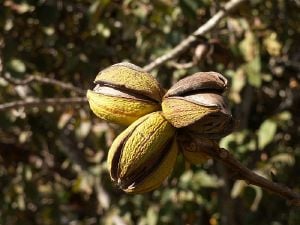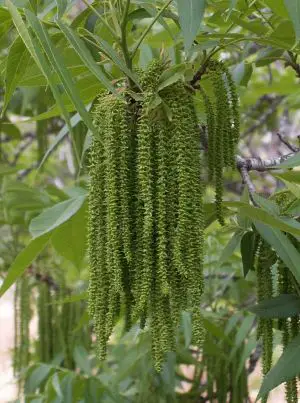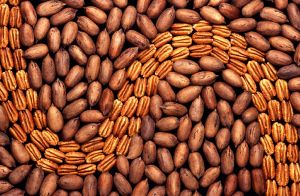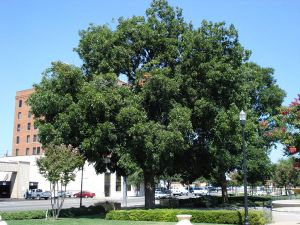Pecan
| Pecan | ||||||||||||||
|---|---|---|---|---|---|---|---|---|---|---|---|---|---|---|
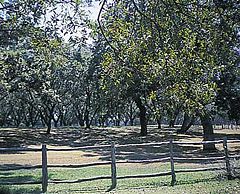 Pecan orchard
Lyndon B. Johnson National Historical Park | ||||||||||||||
|
Secure
| ||||||||||||||
| Scientific classification | ||||||||||||||
| ||||||||||||||
| Carya illinoinensis (Wangenh.) K.Koch |
The Pecan (Carya illinoinensis, commonly misspelled illinoensis) is a species of hickory, native to south-central North America, in the United States from southern Iowa, Illinois and Indiana east to western Kentucky and western Tennessee, south through Oklahoma, Arkansas, to Texas, Mississippi, and Louisiana; and in Mexico from Coahuila south to Jalisco and Veracruz.[1][2]
It is a large deciduous tree, growing to 20–40 m in height (rarely to 44 m,[2]; taller trees to 50–55 m have been claimed but not verified), with a trunk up to 2 m diameter. The leaves are alternate, 40–70 cm long, and pinnate with 9–17 leaflets, each leaflet 2–1 cm long and 2–7 cm broad. The flowers are wind-pollinated, and monoecious, with staminate and pistillate catkins on the same tree; the male catkins are pendulous, up to 18 cm long; the female catkins are small, with three to six flowers clustered together. The fruit is an oval to oblong nut, 2.6–6 cm long and 1.5–3 cm broad, dark brown with a rough husk 3–4 mm thick, which splits off in four sections at maturity to release the thin-shelled nut.[2][3][4][5]
Uses
Pecans first became known to Europeans in the 16th century; the Spanish explorer Cabeza de Vaca saw and wrote first about this plant.[citation needed] The Spaniards brought the pecan into Europe, Asia, and Africa beginning in the 16th century.
The nuts of the Pecan are edible, with a rich, buttery flavor. They can be eaten fresh or used in cooking, particularly in sweet desserts but also in some savory dishes. One of the most common desserts with the pecan as a central ingredient is the pecan pie, a traditional southern U.S. recipe. Pecans are also a major ingredient in praline candy, most often associated with New Orleans.
In addition to the pecan nut, the wood is also used in making furniture, in hardwood flooring, as well as flavoring fuel for smoking meats.
Cultivation
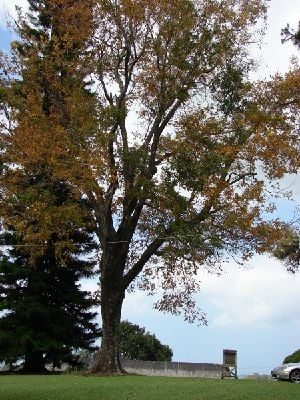
Pecans were one of the most recently domesticated major crops. Although wild pecans were well-known among the colonial Americans as a delicacy, the commercial growing of pecans in the United States did not begin until the 1880s.[6] Today, the U.S. produces between 80% and 95% of the world's pecans, with an annual crop of 150–200 thousand tonnes.[7] The nut harvest for growers is typically around mid-October. Historically, the leading Pecan-producing state in the U.S. has been Georgia, followed by Texas, New Mexico and Oklahoma; they are also grown in Arizona and Hawaii. Outside the United States, pecans are grown in Australia, Brazil, China, Israel, Mexico, Peru and South Africa. They can be grown approximately from USDA hardiness zones 5 to 9, provided summers are also hot and humid.
Pecan trees may live and bear edible nuts for more than three hundred years. They are mostly self-incompatible, because most cultivars, being clones derived from wild trees, show incomplete dichogamy. Generally, two or more trees of different cultivars must be present to pollenize each other.
Diseases
Nutrition
| Pecans Nutritional value per 100 g | ||||||||||
|---|---|---|---|---|---|---|---|---|---|---|
| Energy 690 kcal 2890 kJ | ||||||||||
| ||||||||||
Pecans are a good source of protein and unsaturated fats. A diet rich in nuts can lower the risk of gallstones in women.[8] The antioxidants and plant sterols found in pecans reduce high cholesterol by reducing the "bad" LDL cholesterol levels.[9]
Clinical research published in the Journal of Nutrition (September 2001) found that eating about a handful of pecans each day may help lower cholesterol levels similar to what is often seen with cholesterol-lowering medications.[10] Research conducted at the University of Georgia has also confirmed that pecans contain plant sterols, which are known for their cholesterol-lowering ability.[11]
The U.S. Food and Drug Administration (FDA) has acknowledged this and related research and approved the following qualified health claim: "Scientific evidence suggests, but does not prove, that eating 1.5 ounces per day of most nuts, such as pecans, as part of a diet low in saturated fat and cholesterol, may reduce the risk of heart disease."[12] "This nut is an important source of ellagic acid. Pecan nuts are a good low fat source of vitamin E and also have anti-cancer effects. They can also, if eaten correctly, lead to lower cholesterol levels."[13]
Symbolism
In 1906, Texas Governor James Stephen Hogg made the Pecan tree the state tree of Texas. The story goes that Hogg had a Pecan tree planted at his grave instead of a traditional headstone, requesting that the nuts be distributed throughout the state to make Texas a "Land of Trees".[14]
Etymology and pronunciation
The word pecan is from the Algonquin language, meaning a nut requiring a stone to crack.[15] The pronunciation of pecan is a source of friendly dispute among aficionados. Some people say [pə.ˈkɑn], while others say [ˈpiː.kæn].
ReferencesISBN links support NWE through referral fees
- ↑ Germplasm Resources Information Network: Carya illinoinensis
- ↑ 2.0 2.1 2.2 Flora of North America: Carya illinoinensis
- ↑ Oklahoma Biological Survey: Carya illinoinensis
- ↑ Bioimages: Carya fruits
- ↑ Collingwood, G. H., Brush, W. D., & Butches, D., eds. (1964). Knowing your trees. 2nd ed. American Forestry Association, Washington, DC.
- ↑ Pecans at Texas A&M University
- ↑ Texas Pecan Growers Association
- ↑ Frequent nut consumption and decreased risk of cholecystectomy in women - Tsai et al. 80 (1): 76 - American Journal of Clinical Nutrition
- ↑ LLUAHSC - Spring 2002 Newscope
- ↑ TODAY - September 20, 2001 - LLU news
- ↑ Pecans: Cholesterol Lowering Source of Antioxidants, Fiber, Vitamin E, Protein
- ↑ FDA OK's Nutty Heart Health Claim
- ↑ Health 24 - Healthy foods - Nuts
- ↑ Texas Pecan Growers Association
- ↑ http://www.greenvalleypecan.com/history.asp
External links
- National Pecan Shellers Association
- Carya illinoinensis images at bioimages.vanderbilt.edu
- National Center for Home Food Preservation — Home Preservation of Pecans
- USDA Forest Service: Carya illinoensis
Credits
New World Encyclopedia writers and editors rewrote and completed the Wikipedia article in accordance with New World Encyclopedia standards. This article abides by terms of the Creative Commons CC-by-sa 3.0 License (CC-by-sa), which may be used and disseminated with proper attribution. Credit is due under the terms of this license that can reference both the New World Encyclopedia contributors and the selfless volunteer contributors of the Wikimedia Foundation. To cite this article click here for a list of acceptable citing formats.The history of earlier contributions by wikipedians is accessible to researchers here:
The history of this article since it was imported to New World Encyclopedia:
Note: Some restrictions may apply to use of individual images which are separately licensed.
